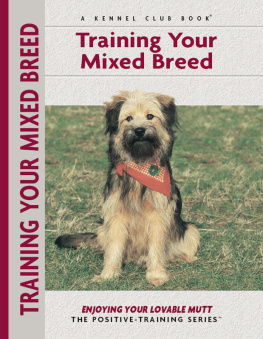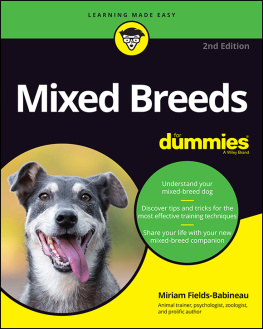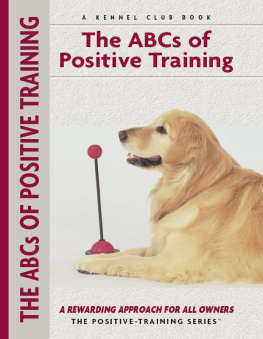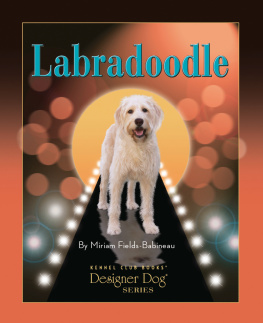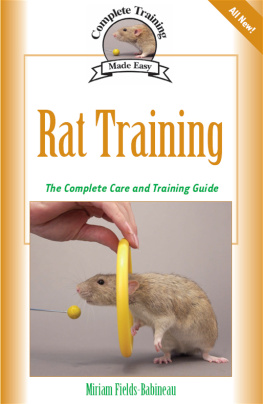Miriam Fields-Babineau - Training Your Mixed Breed
Here you can read online Miriam Fields-Babineau - Training Your Mixed Breed full text of the book (entire story) in english for free. Download pdf and epub, get meaning, cover and reviews about this ebook. year: 2011, publisher: CompanionHouse Books, genre: Detective and thriller. Description of the work, (preface) as well as reviews are available. Best literature library LitArk.com created for fans of good reading and offers a wide selection of genres:
Romance novel
Science fiction
Adventure
Detective
Science
History
Home and family
Prose
Art
Politics
Computer
Non-fiction
Religion
Business
Children
Humor
Choose a favorite category and find really read worthwhile books. Enjoy immersion in the world of imagination, feel the emotions of the characters or learn something new for yourself, make an fascinating discovery.
- Book:Training Your Mixed Breed
- Author:
- Publisher:CompanionHouse Books
- Genre:
- Year:2011
- Rating:5 / 5
- Favourites:Add to favourites
- Your mark:
- 100
- 1
- 2
- 3
- 4
- 5
Training Your Mixed Breed: summary, description and annotation
We offer to read an annotation, description, summary or preface (depends on what the author of the book "Training Your Mixed Breed" wrote himself). If you haven't found the necessary information about the book — write in the comments, we will try to find it.
Miriam Fields-Babineau: author's other books
Who wrote Training Your Mixed Breed? Find out the surname, the name of the author of the book and a list of all author's works by series.
Training Your Mixed Breed — read online for free the complete book (whole text) full work
Below is the text of the book, divided by pages. System saving the place of the last page read, allows you to conveniently read the book "Training Your Mixed Breed" online for free, without having to search again every time where you left off. Put a bookmark, and you can go to the page where you finished reading at any time.
Font size:
Interval:
Bookmark:


The author, Miriam Fields-Babineau, with Golden Retriever puppies.
AUTHOR BIOGRAPHY
Miriam Fields-Babineau has been training dogs and other animals professionally since 1978. She has owned and operated Training Unlimited Animal Training and Animal Actors, Inc., for 25 years. She teaches people how to communicate with and train their dogs, of any age or breed, specializing in behavioral problem-solving.
Ms. Fields-Babineau has authored many animal-related books, including Dog Training with a Head Halter (Barrons Educational Series, Inc.), the e-book How to Become a Professional Dog Trainer (Intellectua.com), Dog Training Basics (Sterling Publishing Co., Inc.) and many more. She writes numerous articles for trade magazines, such as the award-winning Off-Lead Magazine and Practical Horseman. She has produced the videos The First Hello, which addresses how to prepare a dog for an infant, and Dog Training with a Comfort Trainer, which demonstrates how to train a dog using her head-halter design, the Comfort Trainer.
Ms. Fields-Babineau also provides animals for television, film and advertising, having worked with National Geographic, Animal Planet, the History Channel, Warner Films, Orion Films, the Discovery Channel, CBS, the Family Channel and many more. When not training other peoples animal companions, she travels the country, performing in equine and canine competitions as well as exhibiting the skills of her trained felines.
Photographs by:
Mary Bloom, Bernd Brinkmann, Evan Cohen, Billy Deputato, Christopher Deputato, Tracey & Erik Erath, Miriam Fields-Babineau, Isabelle Franais, Amy Gilbert, Mary Ieronimo, Carol Ann Johnson, Jose Martinez, Tammy & Rich Phelan, Dennis Spring, Penni Stagg, Donyale Testa and Alice van Kempen.
The publisher would like to thank all of the owners of the dogs featured in this book.
KENNEL CLUB BOOKS: TRAINING YOUR MIXED BREED
ISBN: 1-59378-592-5
Copyright 2005 Kennel Club Books, LLC
3 Burroughs, Irvine, CA 92618 USA
Cover Design Patented: US 6,435,559 B2 Printed in South Korea
All rights reserved. No part of this book may be reproduced in any form, by photostat, scanner, microfilm, xerography or any other means, or incorporated into any information retrieval system, electronic or mechanical, without the written permission of the copyright owner.
10 9 8 7 6 5 4 3 2 1



IN THE MIX
According to the Mixed Breed Dog Clubs of America, a mixed-breed dog is the offspring of two pure-bred dogs of different breeds. The pairing of a pure-bred with a mixed breed produces mongrels and, if both sire and dam are mixed breeds, then the offspring are mutts. Regardless of definition, a dog that is not identifiable as a pure-bred is not allowed to compete in events offered solely for pure-breds by the American Kennel Club (AKC) and specialty clubs. However, there are several national and international clubs devoted to furthering the sport of mixed-breed dogs. These include the aforementioned Mixed Breed Dog Clubs of America, North American Mixed Breed Registry and various local and regional mixed-breed dog clubs. Several pure-bred dog clubs do allow mixed breeds to compete at their events. These clubs include the United Kennel Club, North American Dog Racing Association and Australian Shepherd Club of America. All of these organizations recognize that mixed-breed dogs are able to train and compete on the same levels as pure-bred dogs.

Bella is a Beagle/Coonhound mix, pictured here in her new home just a few weeks after being adopted from a shelter.

Mario is a Chihuahua mix whose small size belies his huge personality.
One cannot state that a mixed-breed dog is any more or less healthy, intelligent or long-lived than a pure-bred. These factors depend more on the dogs genetics and lifetime care. However, it has been noted that mixed-breed dogs are less likely to contract some of the common hereditary problems that can be seen in pure-breds. These problems occur sometimes as a result of poor breeding and sometimes because certain conditions are difficult to detect no matter how careful the breeder. Common hereditary disorders include hip and elbow dysplasia, retinal atrophy and heart defects, among others. A mixed-breed dog may draw strength from the background of one of his ancestors to overcome the weaknesses of another. He also may gain certain propensities from both sides of his lineage. He may be able to show the abilities to both herd sheep and find lost people, instead of the specialized abilities of the herding dog who is bred solely for herding or the working dog developed solely for search-and-rescue.
All dog breeds were developed for specific tasks. There are breeds that guard, breeds that herd, breeds that have specialized hunting skills and breeds that were meant to warm the hands and feet of their human companions. Your mixed-breed dog is a combination of one or more of these, making him unique unto himself, a pawprint of individuality. Unlike with a pure-bred dog, you will not be able to foretell his exact size or personality until he is fully developed. You will be able to tell certain things, like whether he has long fur or a short coat, floppy ears or erect ones. He may end up weighing 25, 55 or over 100 pounds! Knowledge of who his parents are and how big he is as a pup will give you an idea of eventual size, but there is still no guarantee. Most owners of mixed breeds have no idea of parentage, so the best means of knowing is by learning about the attributes of pure-breds and applying them to observed behaviors and appearances in their mixed-breed dogs. Their genetic codes contain similar information. Size, conformation, coat coloration and even some similarities in behavior can be noted. However, this can often be difficult to decipher while your mixed-breed dog is young.

This dog, an interesting mix of Airedale Terrier, Doberman Pinscher and Schnauzer, grew up to resemble a wiry-coated Doberman.
Knowing more about pure-bred dogs will aid you in better understanding your own mixed breed. Will the dog be suitable in a home with a family that works long hours? How will he get along with young children? Will the dog have a tendency to be hyperactive? Even though the behavioral tendencies of a pure breed can be more predictable, there are individuals that often vary from the norm.
If you know something about your lovely individual, such as the breed(s) of one or both parents, you will have some idea as to what to expect throughout his development, leading to a better understanding of his overall behavior patterns and physical attributes. If you do not have breed specifics, then you hopefully will at least be able to determine to which group of dogs one or both parents belonged, such as the terriers, sporting dogs, hounds and so on. For explanation purposes, we will discuss the breed groups according to AKC classification.
Font size:
Interval:
Bookmark:
Similar books «Training Your Mixed Breed»
Look at similar books to Training Your Mixed Breed. We have selected literature similar in name and meaning in the hope of providing readers with more options to find new, interesting, not yet read works.
Discussion, reviews of the book Training Your Mixed Breed and just readers' own opinions. Leave your comments, write what you think about the work, its meaning or the main characters. Specify what exactly you liked and what you didn't like, and why you think so.

